LSC/UoS BA Business Studies: Sustainable Organization Report
VerifiedAdded on 2023/06/05
|6
|1322
|284
Report
AI Summary
This report delves into the concept of building a sustainable organization, emphasizing its significance in today's business landscape. The introduction defines sustainable business organizations and their commitment to environmental practices, highlighting the importance of aligning core values with societal and environmental benefits to reduce risks and foster long-term growth. Task A explores the concept of sustainability, discussing its three pillars: environmental, social responsibility, and governance (ESG), and its impact on long-term competitive advantages. It provides examples of how organizations like Bio-beans and Bulb energy Ltd. have integrated sustainability into their strategies. Task B examines the attributes and capabilities essential for business success in a complex environment, categorizing them into essential, business-necessary, strategic support, and advantage capabilities, using examples like Unilever and Diageo. The conclusion reiterates the benefits of sustainability for organizational competitiveness, growth, and development, referencing companies like Tesco. The report underscores the importance of sustainability and innovation for achieving competitive advantages in the modern business world.
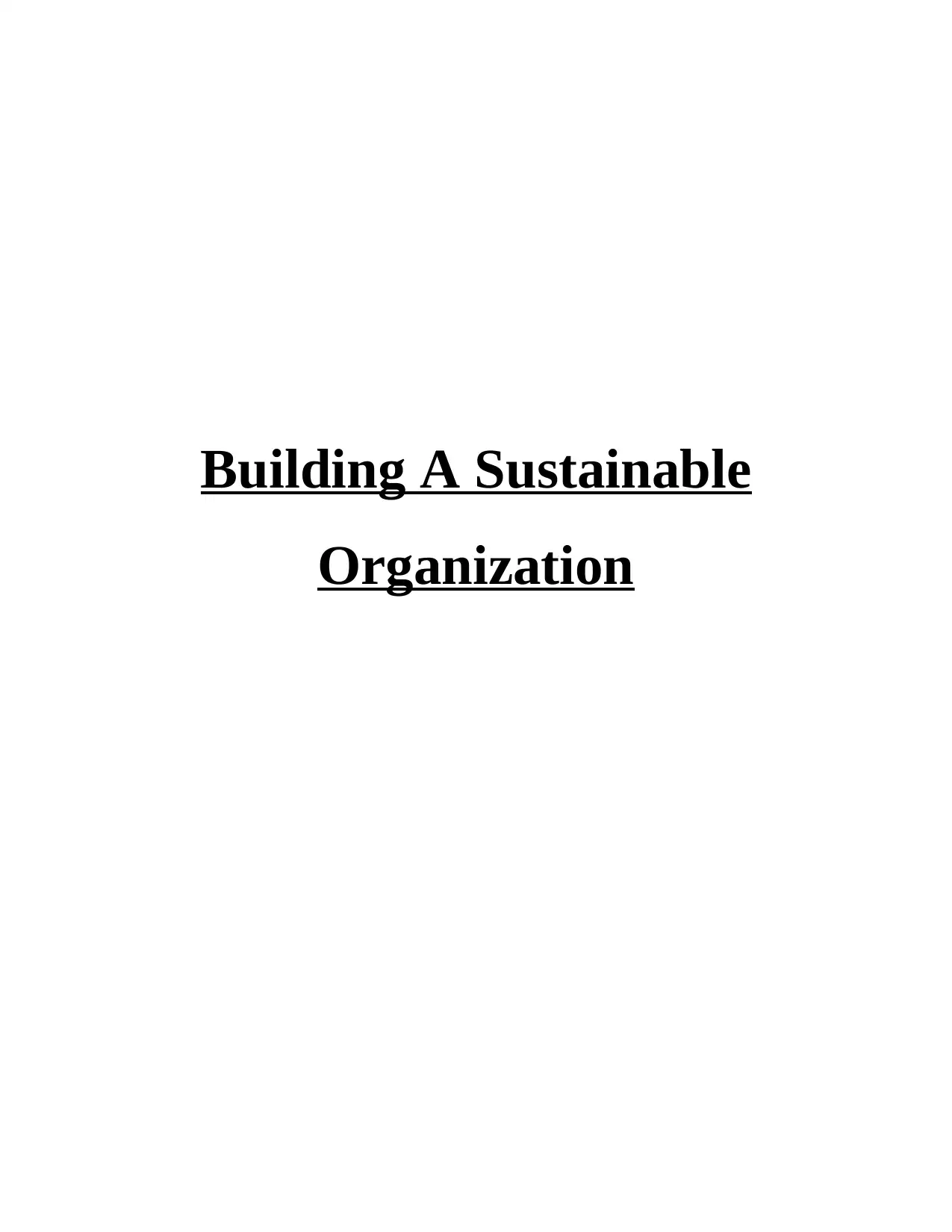
Building A Sustainable
Organization
Organization
Paraphrase This Document
Need a fresh take? Get an instant paraphrase of this document with our AI Paraphraser

TABLE OF CONTENTS
INTRODUCTION ..........................................................................................................................3
MAIN BODY...................................................................................................................................3
Task A..........................................................................................................................................3
Task B..........................................................................................................................................4
CONCLUSION................................................................................................................................5
REFERENCES................................................................................................................................6
INTRODUCTION ..........................................................................................................................3
MAIN BODY...................................................................................................................................3
Task A..........................................................................................................................................3
Task B..........................................................................................................................................4
CONCLUSION................................................................................................................................5
REFERENCES................................................................................................................................6
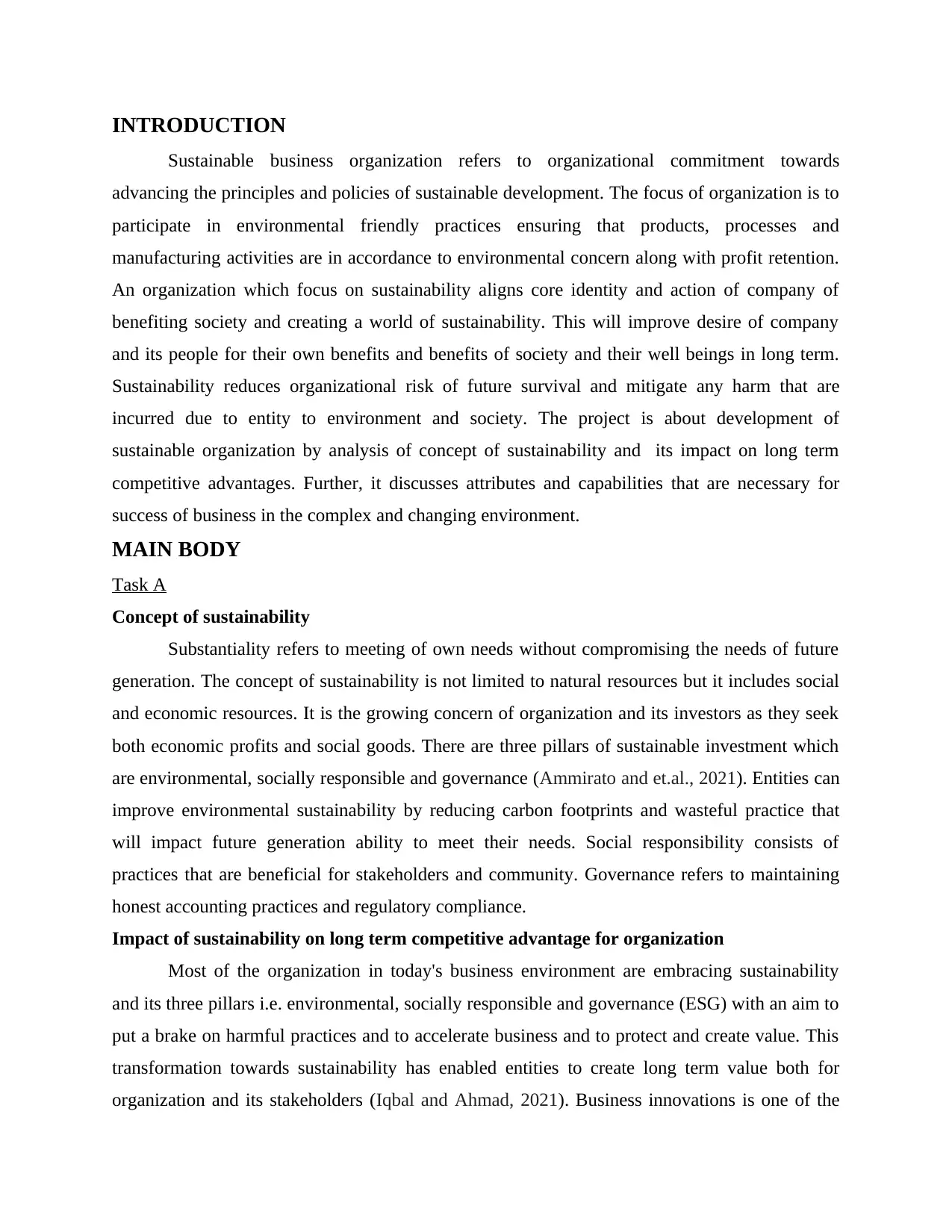
INTRODUCTION
Sustainable business organization refers to organizational commitment towards
advancing the principles and policies of sustainable development. The focus of organization is to
participate in environmental friendly practices ensuring that products, processes and
manufacturing activities are in accordance to environmental concern along with profit retention.
An organization which focus on sustainability aligns core identity and action of company of
benefiting society and creating a world of sustainability. This will improve desire of company
and its people for their own benefits and benefits of society and their well beings in long term.
Sustainability reduces organizational risk of future survival and mitigate any harm that are
incurred due to entity to environment and society. The project is about development of
sustainable organization by analysis of concept of sustainability and its impact on long term
competitive advantages. Further, it discusses attributes and capabilities that are necessary for
success of business in the complex and changing environment.
MAIN BODY
Task A
Concept of sustainability
Substantiality refers to meeting of own needs without compromising the needs of future
generation. The concept of sustainability is not limited to natural resources but it includes social
and economic resources. It is the growing concern of organization and its investors as they seek
both economic profits and social goods. There are three pillars of sustainable investment which
are environmental, socially responsible and governance (Ammirato and et.al., 2021). Entities can
improve environmental sustainability by reducing carbon footprints and wasteful practice that
will impact future generation ability to meet their needs. Social responsibility consists of
practices that are beneficial for stakeholders and community. Governance refers to maintaining
honest accounting practices and regulatory compliance.
Impact of sustainability on long term competitive advantage for organization
Most of the organization in today's business environment are embracing sustainability
and its three pillars i.e. environmental, socially responsible and governance (ESG) with an aim to
put a brake on harmful practices and to accelerate business and to protect and create value. This
transformation towards sustainability has enabled entities to create long term value both for
organization and its stakeholders (Iqbal and Ahmad, 2021). Business innovations is one of the
Sustainable business organization refers to organizational commitment towards
advancing the principles and policies of sustainable development. The focus of organization is to
participate in environmental friendly practices ensuring that products, processes and
manufacturing activities are in accordance to environmental concern along with profit retention.
An organization which focus on sustainability aligns core identity and action of company of
benefiting society and creating a world of sustainability. This will improve desire of company
and its people for their own benefits and benefits of society and their well beings in long term.
Sustainability reduces organizational risk of future survival and mitigate any harm that are
incurred due to entity to environment and society. The project is about development of
sustainable organization by analysis of concept of sustainability and its impact on long term
competitive advantages. Further, it discusses attributes and capabilities that are necessary for
success of business in the complex and changing environment.
MAIN BODY
Task A
Concept of sustainability
Substantiality refers to meeting of own needs without compromising the needs of future
generation. The concept of sustainability is not limited to natural resources but it includes social
and economic resources. It is the growing concern of organization and its investors as they seek
both economic profits and social goods. There are three pillars of sustainable investment which
are environmental, socially responsible and governance (Ammirato and et.al., 2021). Entities can
improve environmental sustainability by reducing carbon footprints and wasteful practice that
will impact future generation ability to meet their needs. Social responsibility consists of
practices that are beneficial for stakeholders and community. Governance refers to maintaining
honest accounting practices and regulatory compliance.
Impact of sustainability on long term competitive advantage for organization
Most of the organization in today's business environment are embracing sustainability
and its three pillars i.e. environmental, socially responsible and governance (ESG) with an aim to
put a brake on harmful practices and to accelerate business and to protect and create value. This
transformation towards sustainability has enabled entities to create long term value both for
organization and its stakeholders (Iqbal and Ahmad, 2021). Business innovations is one of the
⊘ This is a preview!⊘
Do you want full access?
Subscribe today to unlock all pages.

Trusted by 1+ million students worldwide
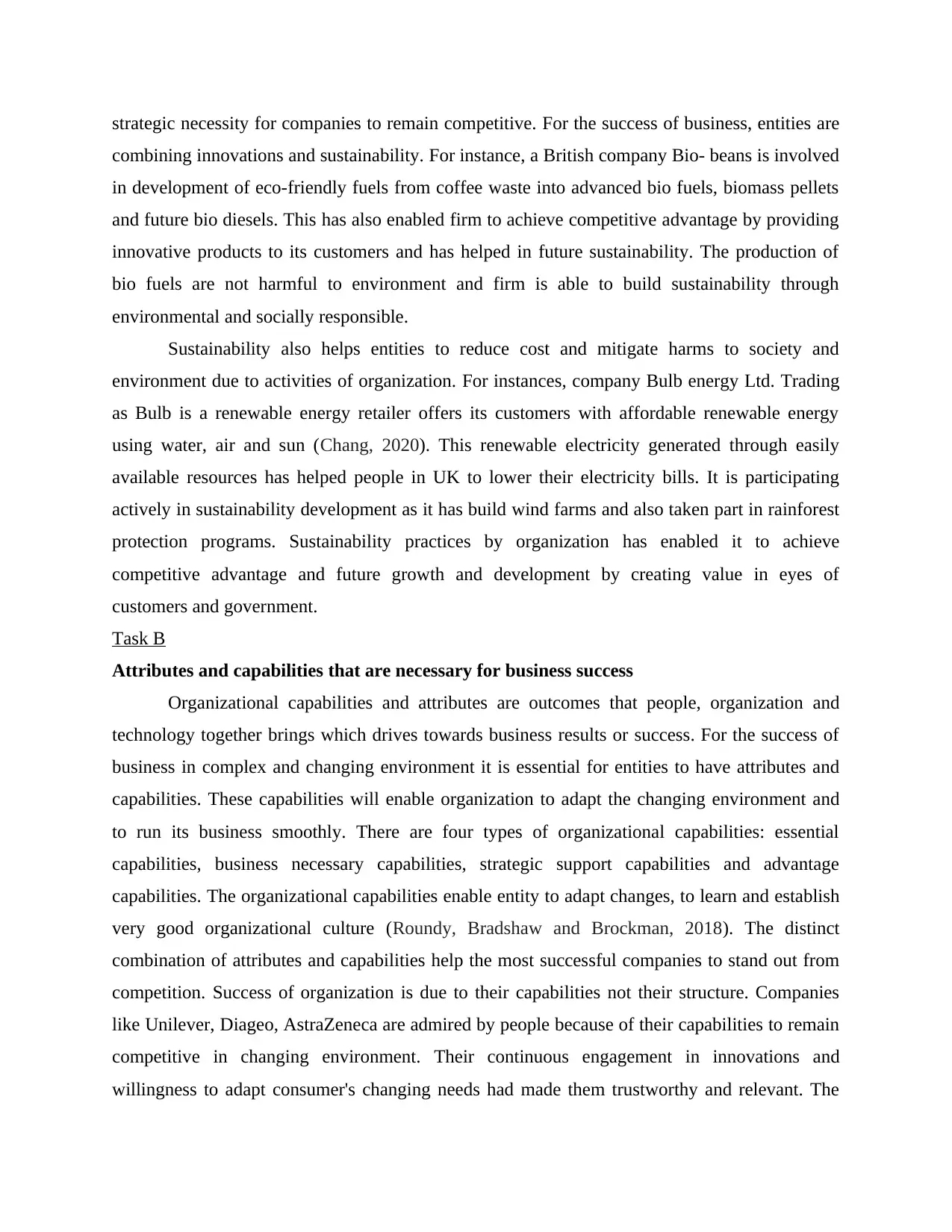
strategic necessity for companies to remain competitive. For the success of business, entities are
combining innovations and sustainability. For instance, a British company Bio- beans is involved
in development of eco-friendly fuels from coffee waste into advanced bio fuels, biomass pellets
and future bio diesels. This has also enabled firm to achieve competitive advantage by providing
innovative products to its customers and has helped in future sustainability. The production of
bio fuels are not harmful to environment and firm is able to build sustainability through
environmental and socially responsible.
Sustainability also helps entities to reduce cost and mitigate harms to society and
environment due to activities of organization. For instances, company Bulb energy Ltd. Trading
as Bulb is a renewable energy retailer offers its customers with affordable renewable energy
using water, air and sun (Chang, 2020). This renewable electricity generated through easily
available resources has helped people in UK to lower their electricity bills. It is participating
actively in sustainability development as it has build wind farms and also taken part in rainforest
protection programs. Sustainability practices by organization has enabled it to achieve
competitive advantage and future growth and development by creating value in eyes of
customers and government.
Task B
Attributes and capabilities that are necessary for business success
Organizational capabilities and attributes are outcomes that people, organization and
technology together brings which drives towards business results or success. For the success of
business in complex and changing environment it is essential for entities to have attributes and
capabilities. These capabilities will enable organization to adapt the changing environment and
to run its business smoothly. There are four types of organizational capabilities: essential
capabilities, business necessary capabilities, strategic support capabilities and advantage
capabilities. The organizational capabilities enable entity to adapt changes, to learn and establish
very good organizational culture (Roundy, Bradshaw and Brockman, 2018). The distinct
combination of attributes and capabilities help the most successful companies to stand out from
competition. Success of organization is due to their capabilities not their structure. Companies
like Unilever, Diageo, AstraZeneca are admired by people because of their capabilities to remain
competitive in changing environment. Their continuous engagement in innovations and
willingness to adapt consumer's changing needs had made them trustworthy and relevant. The
combining innovations and sustainability. For instance, a British company Bio- beans is involved
in development of eco-friendly fuels from coffee waste into advanced bio fuels, biomass pellets
and future bio diesels. This has also enabled firm to achieve competitive advantage by providing
innovative products to its customers and has helped in future sustainability. The production of
bio fuels are not harmful to environment and firm is able to build sustainability through
environmental and socially responsible.
Sustainability also helps entities to reduce cost and mitigate harms to society and
environment due to activities of organization. For instances, company Bulb energy Ltd. Trading
as Bulb is a renewable energy retailer offers its customers with affordable renewable energy
using water, air and sun (Chang, 2020). This renewable electricity generated through easily
available resources has helped people in UK to lower their electricity bills. It is participating
actively in sustainability development as it has build wind farms and also taken part in rainforest
protection programs. Sustainability practices by organization has enabled it to achieve
competitive advantage and future growth and development by creating value in eyes of
customers and government.
Task B
Attributes and capabilities that are necessary for business success
Organizational capabilities and attributes are outcomes that people, organization and
technology together brings which drives towards business results or success. For the success of
business in complex and changing environment it is essential for entities to have attributes and
capabilities. These capabilities will enable organization to adapt the changing environment and
to run its business smoothly. There are four types of organizational capabilities: essential
capabilities, business necessary capabilities, strategic support capabilities and advantage
capabilities. The organizational capabilities enable entity to adapt changes, to learn and establish
very good organizational culture (Roundy, Bradshaw and Brockman, 2018). The distinct
combination of attributes and capabilities help the most successful companies to stand out from
competition. Success of organization is due to their capabilities not their structure. Companies
like Unilever, Diageo, AstraZeneca are admired by people because of their capabilities to remain
competitive in changing environment. Their continuous engagement in innovations and
willingness to adapt consumer's changing needs had made them trustworthy and relevant. The
Paraphrase This Document
Need a fresh take? Get an instant paraphrase of this document with our AI Paraphraser
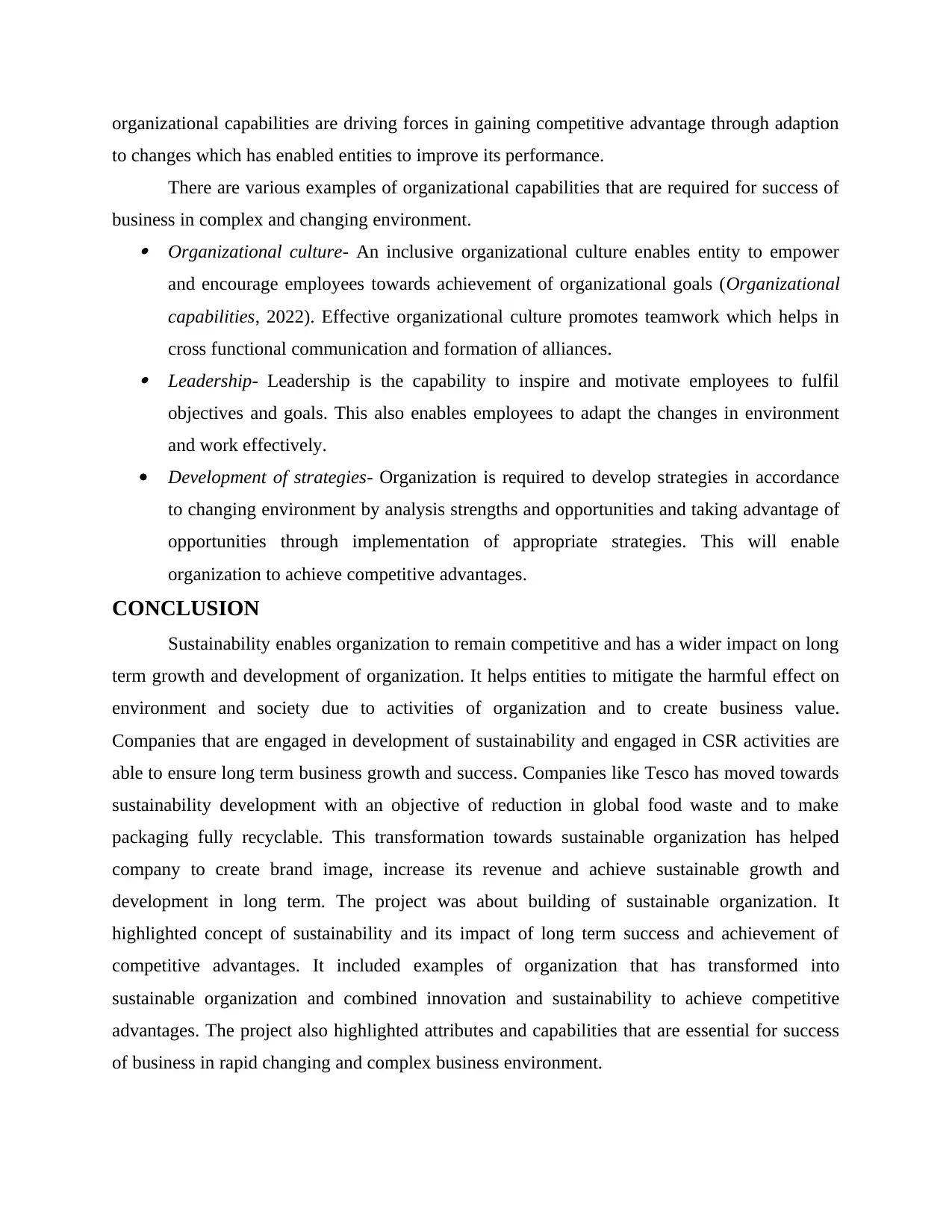
organizational capabilities are driving forces in gaining competitive advantage through adaption
to changes which has enabled entities to improve its performance.
There are various examples of organizational capabilities that are required for success of
business in complex and changing environment. Organizational culture- An inclusive organizational culture enables entity to empower
and encourage employees towards achievement of organizational goals (Organizational
capabilities, 2022). Effective organizational culture promotes teamwork which helps in
cross functional communication and formation of alliances. Leadership- Leadership is the capability to inspire and motivate employees to fulfil
objectives and goals. This also enables employees to adapt the changes in environment
and work effectively.
Development of strategies- Organization is required to develop strategies in accordance
to changing environment by analysis strengths and opportunities and taking advantage of
opportunities through implementation of appropriate strategies. This will enable
organization to achieve competitive advantages.
CONCLUSION
Sustainability enables organization to remain competitive and has a wider impact on long
term growth and development of organization. It helps entities to mitigate the harmful effect on
environment and society due to activities of organization and to create business value.
Companies that are engaged in development of sustainability and engaged in CSR activities are
able to ensure long term business growth and success. Companies like Tesco has moved towards
sustainability development with an objective of reduction in global food waste and to make
packaging fully recyclable. This transformation towards sustainable organization has helped
company to create brand image, increase its revenue and achieve sustainable growth and
development in long term. The project was about building of sustainable organization. It
highlighted concept of sustainability and its impact of long term success and achievement of
competitive advantages. It included examples of organization that has transformed into
sustainable organization and combined innovation and sustainability to achieve competitive
advantages. The project also highlighted attributes and capabilities that are essential for success
of business in rapid changing and complex business environment.
to changes which has enabled entities to improve its performance.
There are various examples of organizational capabilities that are required for success of
business in complex and changing environment. Organizational culture- An inclusive organizational culture enables entity to empower
and encourage employees towards achievement of organizational goals (Organizational
capabilities, 2022). Effective organizational culture promotes teamwork which helps in
cross functional communication and formation of alliances. Leadership- Leadership is the capability to inspire and motivate employees to fulfil
objectives and goals. This also enables employees to adapt the changes in environment
and work effectively.
Development of strategies- Organization is required to develop strategies in accordance
to changing environment by analysis strengths and opportunities and taking advantage of
opportunities through implementation of appropriate strategies. This will enable
organization to achieve competitive advantages.
CONCLUSION
Sustainability enables organization to remain competitive and has a wider impact on long
term growth and development of organization. It helps entities to mitigate the harmful effect on
environment and society due to activities of organization and to create business value.
Companies that are engaged in development of sustainability and engaged in CSR activities are
able to ensure long term business growth and success. Companies like Tesco has moved towards
sustainability development with an objective of reduction in global food waste and to make
packaging fully recyclable. This transformation towards sustainable organization has helped
company to create brand image, increase its revenue and achieve sustainable growth and
development in long term. The project was about building of sustainable organization. It
highlighted concept of sustainability and its impact of long term success and achievement of
competitive advantages. It included examples of organization that has transformed into
sustainable organization and combined innovation and sustainability to achieve competitive
advantages. The project also highlighted attributes and capabilities that are essential for success
of business in rapid changing and complex business environment.
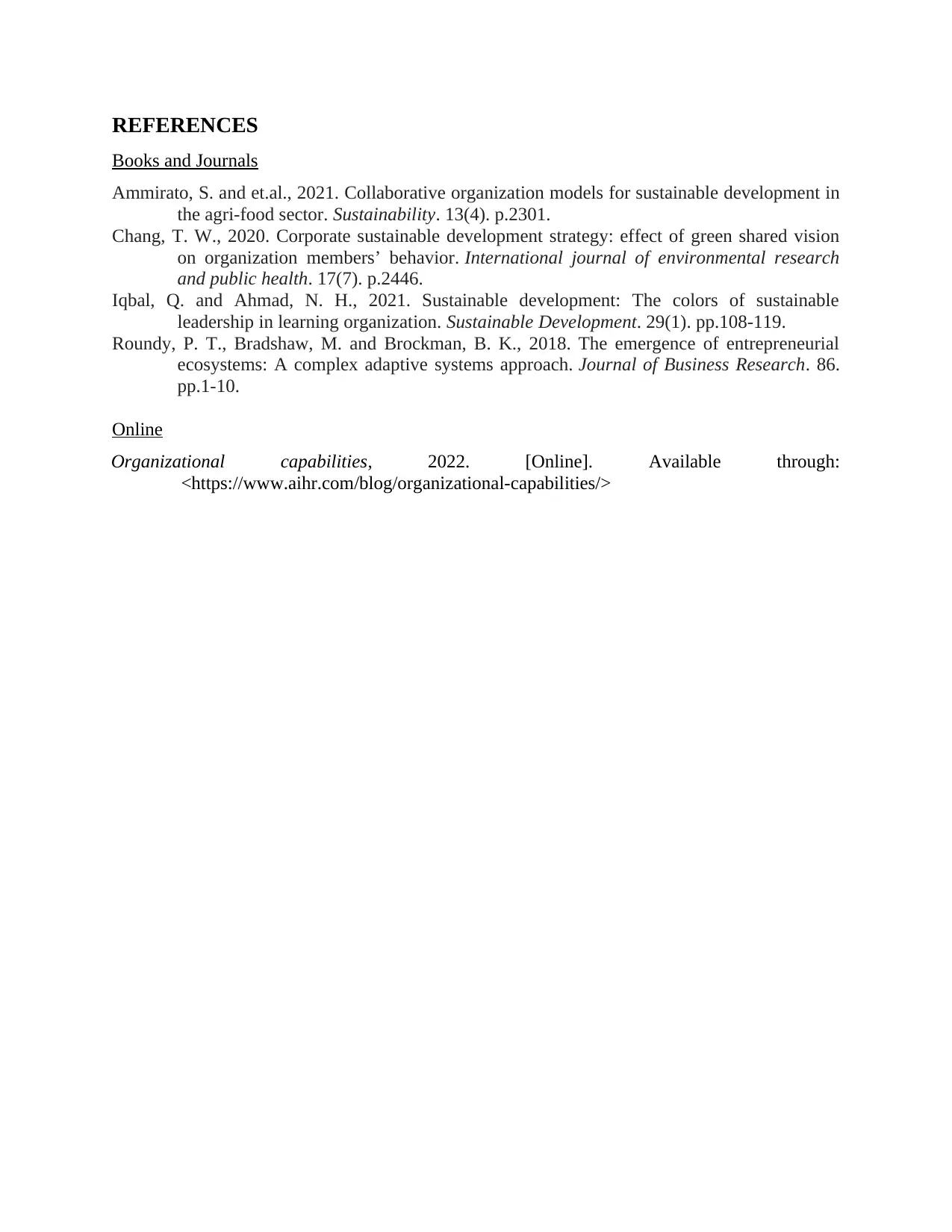
REFERENCES
Books and Journals
Ammirato, S. and et.al., 2021. Collaborative organization models for sustainable development in
the agri-food sector. Sustainability. 13(4). p.2301.
Chang, T. W., 2020. Corporate sustainable development strategy: effect of green shared vision
on organization members’ behavior. International journal of environmental research
and public health. 17(7). p.2446.
Iqbal, Q. and Ahmad, N. H., 2021. Sustainable development: The colors of sustainable
leadership in learning organization. Sustainable Development. 29(1). pp.108-119.
Roundy, P. T., Bradshaw, M. and Brockman, B. K., 2018. The emergence of entrepreneurial
ecosystems: A complex adaptive systems approach. Journal of Business Research. 86.
pp.1-10.
Online
Organizational capabilities, 2022. [Online]. Available through:
<https://www.aihr.com/blog/organizational-capabilities/>
Books and Journals
Ammirato, S. and et.al., 2021. Collaborative organization models for sustainable development in
the agri-food sector. Sustainability. 13(4). p.2301.
Chang, T. W., 2020. Corporate sustainable development strategy: effect of green shared vision
on organization members’ behavior. International journal of environmental research
and public health. 17(7). p.2446.
Iqbal, Q. and Ahmad, N. H., 2021. Sustainable development: The colors of sustainable
leadership in learning organization. Sustainable Development. 29(1). pp.108-119.
Roundy, P. T., Bradshaw, M. and Brockman, B. K., 2018. The emergence of entrepreneurial
ecosystems: A complex adaptive systems approach. Journal of Business Research. 86.
pp.1-10.
Online
Organizational capabilities, 2022. [Online]. Available through:
<https://www.aihr.com/blog/organizational-capabilities/>
⊘ This is a preview!⊘
Do you want full access?
Subscribe today to unlock all pages.

Trusted by 1+ million students worldwide
1 out of 6
Related Documents
Your All-in-One AI-Powered Toolkit for Academic Success.
+13062052269
info@desklib.com
Available 24*7 on WhatsApp / Email
![[object Object]](/_next/static/media/star-bottom.7253800d.svg)
Unlock your academic potential
Copyright © 2020–2025 A2Z Services. All Rights Reserved. Developed and managed by ZUCOL.

